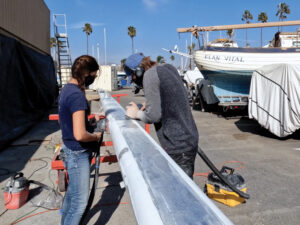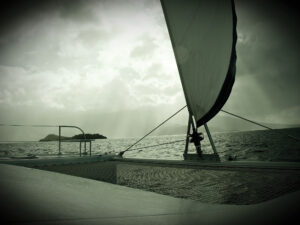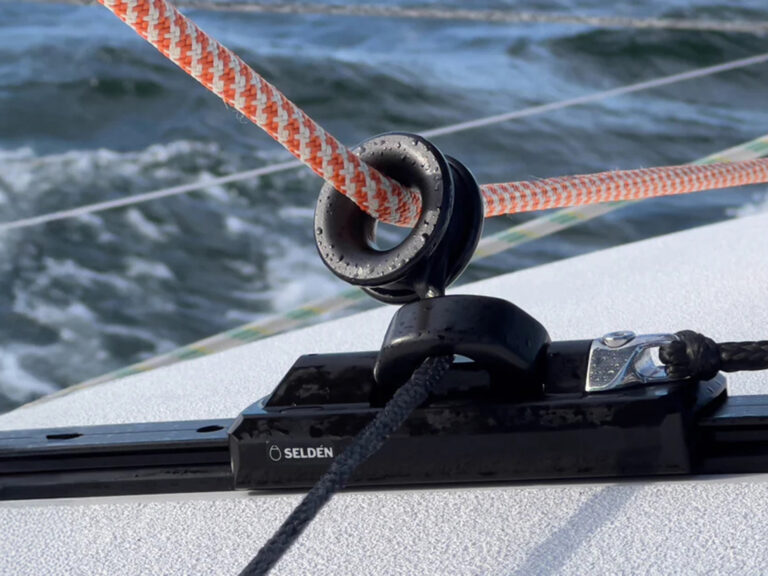
We can’t see the wind, but we can see what it is doing to many objects on the water. Understanding the patterns and trends of the ever-changing wind helps us sail faster, more efficiently, and on a more direct course toward our destination.
Reading the wind is one of the great joys of sailing. Start by wearing sunglasses to dampen glare. This makes it easier to detect small changes of the ripples that wind causes on the water. I use prescription sunglasses to help me read the wind.
Stand up in the boat so that you can see farther. Study one section of the horizon at a time. In a minute or two, you will be able to recognize what the wind is doing.
Start by looking at the wind within 10 boatlengths, and then extend your view farther out, eventually all the way to the horizon. Study the patterns. Out loud, say where you think the wind is best.
There are many clues. The first indicator is the water. Dark patches with ripples close together indicate more wind. Look for the intensity of the patches. That means puffs. You can also see if the puffs are coming from different directions.
The next indicator is your sails. The wind flows around the sails and lets you know exactly what is happening around your boat. I use an apparent-wind indicator (a masthead fly) to see what direction the wind is flowing. Other boats sailing in your vicinity are a helpful source of information too. If, for example, you see a boat well ahead of you steering a higher course, that suggests you are about to be lifted (able to sail a higher course toward your destination).
A change of direction that forces you farther off course is called a header. Often, when wind changes direction, it is part of a puff with more velocity. Anticipate a puff just before it flows into your sails. If it is a strong gust, be prepared to ease out your sails and head up a few degrees to lessen the effects of the puffs.
Flags flying on the shoreline are helpful in trying to figure out if the wind is going to change direction. A set of anchored boats is another helpful source. (Be mindful that current flow can affect how a boat sits at anchor.)
If a strong gust approaches your boat, then alert the rest of the crew that you are about to get a blast of wind. Crews don’t like surprises. Suddenly heeling over can startle an unsuspecting crew.
Smokestacks are another good source of wind-direction information. A smokestack is high in the air and indicates what direction the wind is blowing at a higher elevation.
While you are sailing, keep a mental note of how each puff of wind is affecting your boat. The patterns repeat throughout the day. On a light-air day, head for a set of clouds. Often, good wind is underneath clouds. On a very-light-wind day, you can feel a subtle breeze on your neck. Wet a finger and hold it in the air, and you can feel which direction the wind is blowing.
Buddy Melges once told me that he looks to see what direction cattle are standing onshore so they can feel the wind on their backsides.
Thermal factors have a big impact on wind. When air heats up on land, it rises. A cooler breeze over the water fills in to take the place of the rising air. This is called a thermal or a sea breeze.
Before sailing, take a few minutes to check out different forecasts by weather services. My favorites include Windy, PredictWind, SailFlow and the National Weather Service. I like looking at more than one source to get a sense of what might happen while I am on the water.
For long-distance passages, consider subscribing to a private weather service. On an expedition to Antarctica, our crew engaged a weather service that gave us accurate forecasts every 12 hours. We received the information via email on a satellite phone. Many grand-prix racing crews use customized weather services as well.
The locals can be helpful. A gardener at a yacht club used to give me tips every Saturday before I went out racing. He would say: “There is a lot of dew on the grass this morning. There’s going to be a strong breeze from the south.” Or: “I noticed cobwebs on the fence. Probably going to be a westerly wind today.” I smiled at the lore of the gardener, and yet his forecast generally proved accurate, so I always factored his commentary into my thinking.
Expect the wind to be choppy and confused in harbors and around moored boats. You are better off sailing in open water. Areas with many powerboats chop up the waves and cause confusion reading the wind. I try to sail in areas with as few power vessels as possible.
Superstar sailor Buddy Melges once told me that he looks to see what direction cattle are standing on the shoreline so they can feel the wind on their backsides. Melges also advised watching the direction birds take off because they usually fly into the wind to generate lift.
When you sail into a gust of wind, it helps to use your sail trim, steering, and weight placement to maintain an even keel. When a boat heels over too far, it makes leeway. The rudder and keel stall, making it difficult to steer, and the boat slows down.
When I am daysailing, I like to keep my boat sailing fast. The helm feels better, and the boat performs better. So, I ask the crew to sit to windward in a breeze and to leeward in light wind. If you plan to make a maneuver, let the crew know well in advance so that they will be prepared to switch sides of the boat. Reading the wind accurately will help you understand when it is time to tack or jibe.
More than anything, practice. I’ve spent my entire career studying the wind. Predicting what is going to happen will make your sailing more enjoyable.








